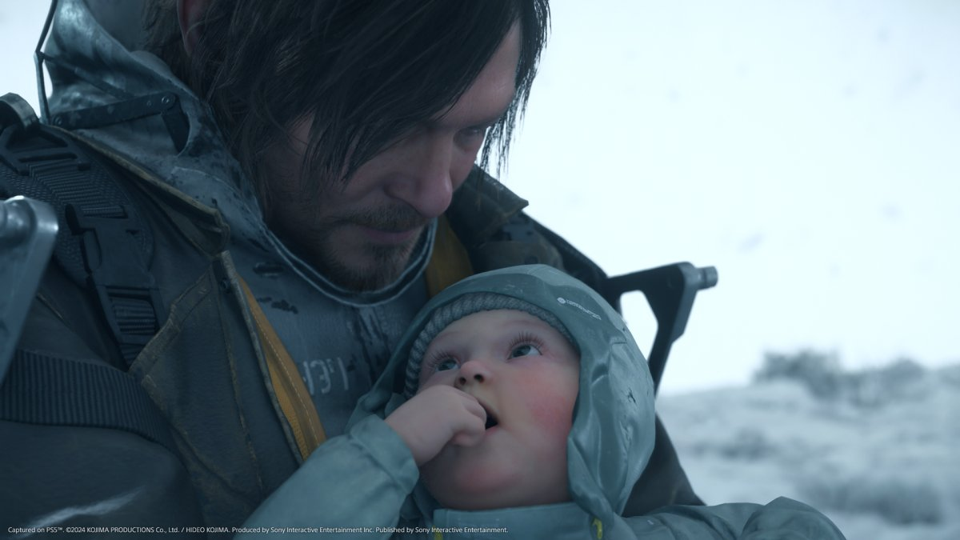Should 'Death Stranding 2: On The Beach' Include Content Warnings?

Death Stranding 2: On The Beach
Credit: SonyContent warning: This post discusses content warnings and therefore invariably includes discussion of content that may require a warning.
Over at Polygon, Josh Broadwell argues that Hideo Kojima’s latest game, Death Stranding 2: On The Beach, “desperately needed content warnings” on release. There’s a scene in the game, which I won’t spoil here, but which involves graphic violence involving a child and attempted suicide, that some might find triggering. Broadwell argues that such scenes deserve content warnings beyond the M-rating the game received via the ESRB.
It’s a somewhat straightforward argument, though Broadwell takes things in a peculiar direction when he brings up another 2025 release, Clair Obscure: Expedition 33. Writes Broadwell:
Content warnings don’t have to be extensive, dramatic, or even mandatory to view. The more notice a developer draws to it, the worse of an impact it can have. Take Clair Obscur: Expedition 33 as a negative example. It begins with an unskippable notice that the story includes scenes of attempted suicide, along with a few other issues such as depictions of violence. The violence is hardly surprising for an M-rated game where fighting plays a crucial role, and the way events unfold at the start of the game make it evident how and when the other warned scenario will happen. As much as I appreciate the heads-up about what might be in store, the presentation is clunky and silly, and it works against the drama Sandfall Interactive tried creating in Expedition 33’s pivotal early moments.
Broadwell then argues that content warnings are handled better in the game Expelled, which includes a tab on the top left corner that allows players to read through an extensive list of potential triggers.
This is a strange argument. If you believe that content warnings are important in media (whether that’s video games or TV shows or movies or whatever) then the example of Clair Obscure: Expedition 33 actually makes a lot more sense, clunky or otherwise. The warning is not so much silly as it is obvious. It can’t be avoided or skipped. Generally, if you think warnings ought to be included to protect sensitive consumers of media from sensitive or potentially disturbing content, making them easy to miss undermines their efficacy.
Play Puzzles & Games on Forbes
The equivalent for a TV show would be a separate content warning tab next to the Watch Now button on a streaming service. You’d scroll over and click on the content warning prior to watching the episode. But again, anyone who didn’t know this was there or didn’t spot it would simply miss the warning altogether.
That being said, I am also leary of the cultural implications of content warnings in general. That isn’t to say I’m against them entirely, but I do think we have a system in place that gives consumers a good idea of the kind of content they’re going to be playing or watching already in the form of age-ratings. On the other hand, I have empathy for people who have gone through traumatizing experiences in their personal lives. Shows like Outlander are riddled with extremely graphic and disturbing scenes involving rape and sexual assault, and for victims, suddenly seeing that take place onscreen can be genuinely disturbing. For those who have lost loved ones to suicide, or who have had their own suicidal thoughts, suddenly seeing that take place in a game or movie might be equally difficult. There is no doubt in my mind that this type of violence can land very differently than seeing a bloody battle between Jacobites and British soldiers, or shooting enemies in a video game.
The question is whether a content warning (or trigger warning) is the right way to actually inform people of the potentially triggering content. There is an argument to be made that sensitive viewers should put in the time to research what they’re getting into, rather than warn everyone ahead of time given that such warnings often contain spoilers. There’s also an argument to be made that we do no one any favors by softening harsh realities, and that this kind of media can actually be therapeutic in its own right. Confronting triggers is one of the only methods psychologists have to effectively deal with PTSD. Content warnings can also be a slippery slope toward censorship, something that critics of age-ratings or explicit content warnings on music have argued for decades.
Then there is the snowball effect. From a 2023 piece in The Atlantic, Jill Filipovic, an early supporter of trigger warnings, notes how things quickly spun out of control online:
I was convinced that such warnings were sometimes necessary to convey the seriousness of the topics at hand (the term deeply problematic appears a mortifying number of times under my byline). Even so, I chafed at the demands to add ever more trigger warnings, especially when the headline already made clear what the post was about. But warnings were becoming the norm in online feminist spaces, and four words at the top of a post—“Trigger Warning: Sexual Assault”—seemed like an easy accommodation to make for the sake of our community’s well-being. We thought we were making the world just a little bit better. It didn’t occur to me until much later that we might have been part of the problem.
The warnings quickly multiplied. When I wrote that a piece of conservative legislation was “so awful it made me want to throw up,” one commenter asked for an eating-disorder trigger warning. When I posted a link to a funny BuzzFeed photo compilation, a commenter said it needed a trigger warning because the pictures of cats attacking dogs looked like domestic violence. Sometimes I rolled my eyes; sometimes I responded, telling people to get a grip. Still, I told myself that the general principle—warn people before presenting material that might upset them—was a good one.
While it makes intuitive sense to include some kind of warning ahead of extreme content, it’s easy to see how this concept can be applied to anything that might upset anyone for any reason, including warnings popping up to inform us that a piece of media was made in a different era. Recently we’ve seen content warnings posted ahead of older movies. For instance, this pops up ahead of the 1998 buddy cop movie Rush Hour now:
Not only is this awkwardly phrased, this feels less like an attempt to actually protect sensitive viewers and more like self-preservation. There is nothing extreme in Rush Hour. This isn’t Handmaid’s Tale or Caligula.
In 2020, Disney began putting a rather odious content warning at the beginning of many of its older animated features. It read:
“This program includes negative depictions and/or mistreatment of people or cultures. These stereotypes were wrong then and are wrong now. Rather than remove this content, we want to acknowledge its harmful impact, learn from it and spark conversation to create a more inclusive future together. Disney is committed to creating stories with inspirational and aspirational themes that reflect the rich diversity of the human experience around the globe.”
This was certainly in keeping with the heady days of the late 2010’s and early 2020’s: Preachy, self-serving, filled with the era’s gusto for corporate-stamped, performative social justice. You can almost hear whoever wrote it patting themselves on the back. As the zeitgeist for self-censorship has cooled, Disney recently ditched this lengthy warning in favor of something much more understated and sober: “This program is presented as originally created and may contain stereotypes or negative depictions.”
Even this feels like an unnecessary warning, though as far as content warnings go it’s about as good as anyone could hope for, especially since we should present older content as it was originally created. Obviously older movies are going to include less sensitive depictions of other races and cultures. Our views about race and gender have shifted radically over the past few decades, and not just in more radical circles but across the general public. Nobody thinks that the people making Disney movies now have the same values and beliefs as the people who came up with the “Why is the Red Man red?” sequence in Peter Pan, which even as a kid in the 80s’ I thought was astonishingly racist. We should not have to explain this. We should trust that audiences and gamers can use their critical thinking skills. The more we require that, the more likely those skills will be honed.
And if we cordone off content that’s troubling and sensitive, we risk doing even more damage to people who might benefit from it the most. Plenty of research suggests that people with PTSD benefit enormously from exposure therapy – experiencing triggers in a safe space, confronting trauma head-on but in a way that doesn’t actually expose someone to real danger. Video games and other media can be deeply therapeutic for some people. Content warnings can have the reverse effect, leading people suffering from PTSD to avoid confronting their trauma or begin fashioning their sense of self around a trauma identity.
A large study by Jones, Bellet, and McNally found that trigger warnings reinforced the belief on the part of trauma survivors that trauma was central (rather than incidental or peripheral) to their identity. The reason that effect may be concerning is that trauma researchers have previously established that a belief that trauma is central to one’s identity predicts more severe P.T.S.D.; Bellet called this “one of the most well documented relationships in traumatology.” The perverse consequence of trigger warnings, then, may be to harm the people they are intended to protect.
The piece also notes:
If those suffering from P.T.S.D. were responding to trigger warnings by opting out of reading or discussing the flagged content, then, as McNally has pointed out, that would be concerning from a mental-health point of view, because the clinical consensus is that avoiding triggers worsens P.T.S.D.
Other studies show that the trigger warnings themselves can lead to a PTSD response, heightening anxiety.
Perhaps in this light, the optional content warning in Expelled really is the correct way to include these types of things in games. But if that’s true, it also underscores how ultimately unnecessary and perhaps even counterproductive content warnings are in the first place, and how misguided their ubiquitous adoption has been. I believe that trigger warnings came from a place of good intentions before being warped by a larger cultural movement. As for Death Stranding 2, anyone who has played the first game or really any title from Mr. Kojima ought to know what they’re getting into.











